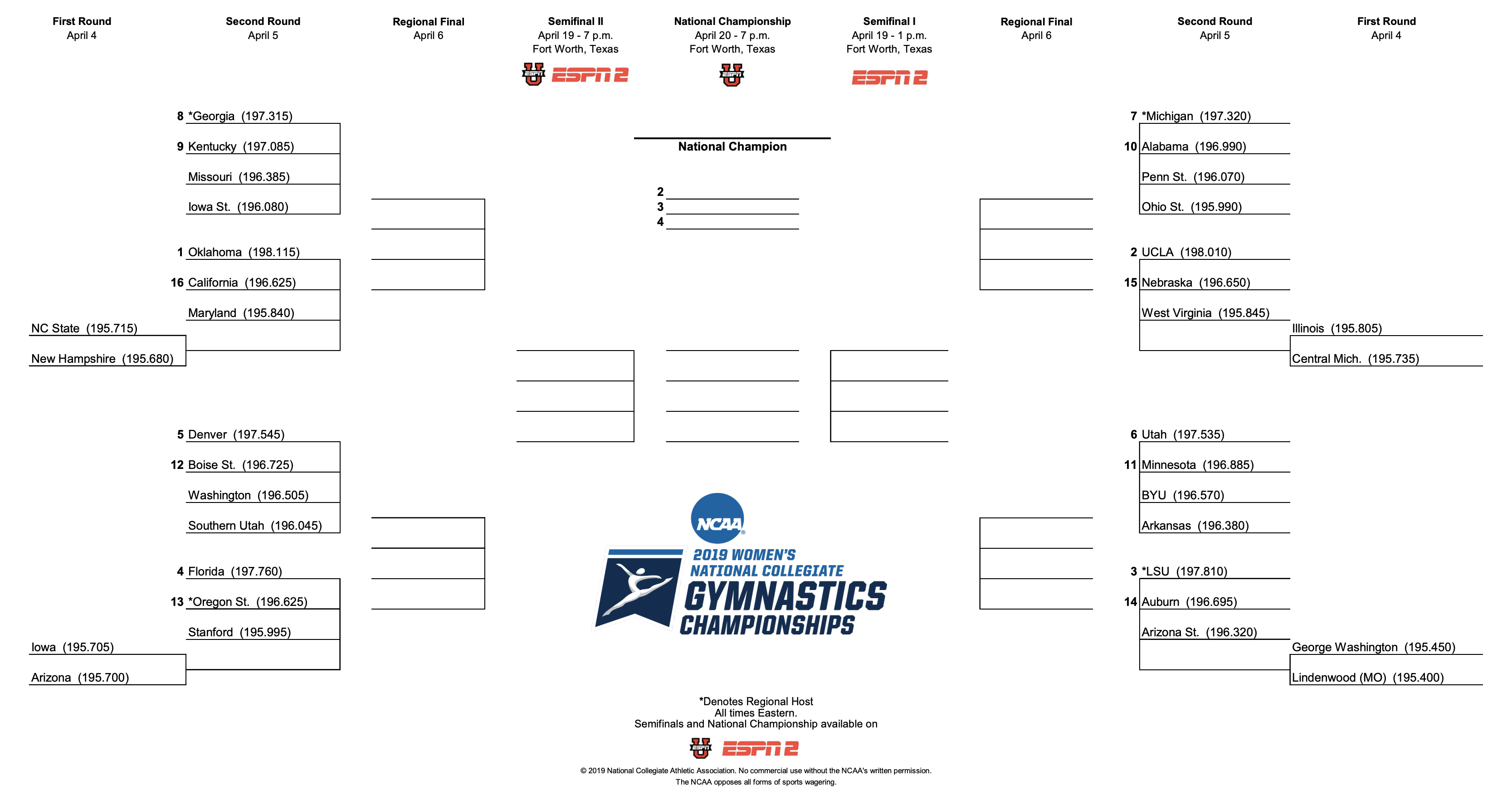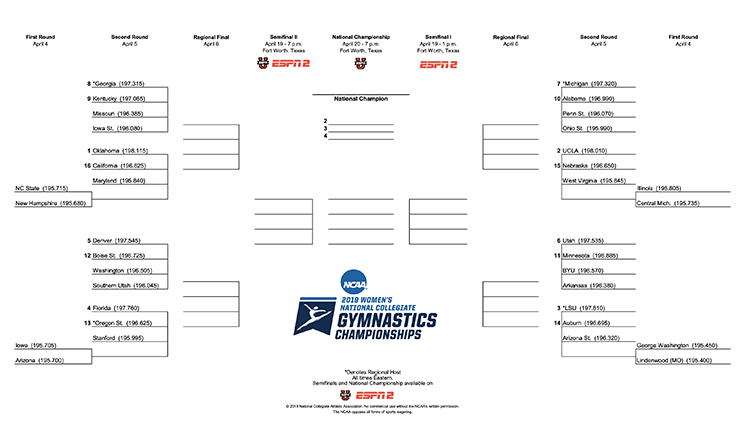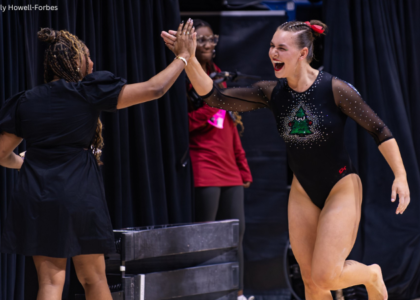For years, coaches and fans alike have been pushing for a change to the NCAA gymnastics postseason format to eliminate byes, make it easier for individuals to qualify and streamline the process of making the national championships. In 2019, the new format finally takes effect. While it may seem confusing on the surface, the steps to qualification are actually quite simple, and we’re here to explain it all—from how teams advance to what happens to individuals to the tie-breaking procedure.
Qualifying
Teams
We can’t talk about the postseason format without first explaining how teams get there to begin with. The top 36 teams based on National Qualifying Score (NQS) qualify to regionals. The top 16 are seeded while No. 17-36 are placed geographically. The bottom eight teams compete in the first round and the top 28 essentially get a bye and automatically advance to round two.
For placement, teams ranked Nos. 1/8/9/16 are seeded into one regional, Nos. 2/7/10/15 are in another, Nos. 3/6/11/14 in the third and Nos. 4/5/12/13 in the final regional. If there are host conflicts based on how teams finish the regular season, “the lowest seeded host in the group will be exchanged with a non-host that holds a spot not greater or less than two seeded positions (and preferably one position) when possible.” However, in 2019, Oregon State had to be shifted three positions due to conflicts in the first two adjusted scenarios. Teams outside the top 16 are placed geographically where possible.
If a team declines its spot at regionals, the next-highest-ranked team based on NQS will be selected.
Individuals
The top 12 all arounders and top 16 individual event specialists on each event, not on a top 28 qualifying team, make it to regionals. Individuals from teams competing in round one are included in the list of individual qualifiers in case their team doesn’t advance out of round one. No alternates are named for regionals or nationals for individual qualifiers. For the team that advances out of round one, its individuals’ spots will not be filled.
These individuals are placed at a regional competition geographically. To determine the session in which they compete, the NCAA outlined the following, confusing, parameters: “To ensure the top-seeded teams have the least number of individuals competing with them, the committee will pair the highest-ranked all-arounder at the site with the lowest-seeded team (or lowest NQS team at the site first, then proceed to the seeded teams), the next highest all-arounder with the next lowest-seeded team, etc. to ensure the top-seeded teams have the fewest number of individuals competing with them, which maintains integrity of the bracket and fairness for both teams and individuals.” Essentially, the top-ranked all arounder at a region will be paired with the “worst” team based on seeding and/or NQS.
The Format
Teams
In its simplest form, the format is as so:
- The top 36 teams make regionals.
- There are four regional hosts with nine teams at each.
- Two teams compete in round one on Thursday while the remaining seven get a round-one bye and automatically advance to round two. The higher-ranked team will compete in Olympic order.
- Round two on Friday is two sessions, the first with four teams and the second with three plus the winner of round one.
- The top two teams from each session advance to round three.
- Round three on Saturday is one session with four teams.
- The top two teams advance to the national semifinals (Friday, April 19).
- Qualifiers from two regionals feed into semifinal one while the other semifinal features qualifiers from the other two regionals.
- The top two teams from each semifinal qualify to finals.
- The final (Saturday, April 20) features four teams where the winner is crowned the national champion.
Visually, the format takes shape as a bracket, similar to basketball’s March Madness.

In 2019, the regional hosts are Ann Arbor (Michigan), Athens (Georgia), Baton Rouge (LSU) and Corvallis (Oregon State). Qualifiers from Ann Arbor and Baton Rouge will compete in national semifinal one while qualifiers out of Athens and Corvallis will compete in semifinal two.
Round one will take place on Thursday, April 4 at 3 p.m. in each host’s respective time zone. Round two’s sessions are at 2 p.m. and 7 p.m. in each time zone on Friday, April 5 and round three is at 7 p.m. in each time zone on Saturday, April 6. The national semifinals will be held on Friday, April 19 at 1 p.m. and 7 p.m. ET and finals are on Saturday, April 20 at 7 p.m. ET, all in Fort Worth, Texas.
It is suspected that there is no competition on Sunday so that, if it advances, BYU would be able to compete since it observes Sabbath on Sundays. This is backed up by the following, based on bylaws 31.1.4.1 and 31.1.4.2 in the NCAA Division I Manual: “If a participating institution has a written policy against competition on a particular day for religious reasons, it shall inform the NCAA national office on or before Sept. 1 of each academic year in order for it or one of its student-athletes to be excused from competing on that day. The championship schedule shall be adjusted to accommodate that institution.”
Future years’ hosts include Denver, Oklahoma, Penn State and UCLA in 2020; Missouri, New Hampshire, Utah and West Virginia in 2021; and Auburn, Kentucky, N.C. State and Washington in 2022. Nationals are in Fort Worth all three years.
Individuals
All individual competitors will compete and qualify to nationals out of the Friday round two sessions. Results will be combined over the two sessions to determine the top finisher not on a qualifying team in the all around and on each event. But keep in mind that taking out teams for the “not on a qualifying team” clause doesn’t just include the teams that make it to round three on Saturday. It also includes those teams that don’t qualify out of that Saturday session, so individual qualifiers won’t be known until after all competition at a regional concludes Saturday night.
Here’s an example:
Say the combined top five on bars from Friday’s meets at the Athens regional are 1. Maggie Nichols (OU), 2. Marissa Oakley (UGA), 3. Emi Watterson (Cal), 4. Mei Li Costa (Brown) and 5. Mollie Korth (UK). Georgia and Kentucky, and Oklahoma and California qualify out of their respective sessions to Saturday’s competition. The individual will then have to wait to see which of those four teams qualify to nationals to determine which names to take out of these individual standings.
In this example, Oklahoma and Georgia advance as full teams, meaning you would take out all Oklahoma and Georgia gymnasts in Friday’s combined individual event and all around standings, meaning Emi Watterson (Cal) would earn a trip to nationals on bars.
The bottom line:
Combine event and all around results for the two Friday sessions, wait until competition concludes Saturday and scratch through every name of a gymnast from a team going to nationals. The top individual on each event and in the all around advances.
This results in four all arounders and four individuals on each event qualifying to compete at the national championships.
At nationals, all individuals will compete on Friday in one of the two semifinal sessions. All around and event results from each session will be combined to determine individual champions and All-Americans.
Tie-Breaking
Round One
If the two round one teams tie at the end of the competition, it will be broken by counting all six scores per event. If a tie still exists, the top and bottom scores for each event are thrown out and the remaining four are added to get a full team score.
Round Two
Team ties during round two will be broken the same way as in round one (see above).
Any ties in the all around are broken by looking at the highest single event score, then the next highest and so forth until the tie is broken. If there is still a tie, all four judges’ scores will be counted and averaged for all four events.
For individual event ties, all four judges’ scores will be counted and averaged. If a tie still exists, the head judge score will be the tie breaker. If a tie still exists, the individual with the higher NQS will advance.
Round Three
Team ties during round three will be broken the same way as in round one and two (see above).
National Semifinals
Team ties during the national semifinals will be broken the same way as in round one, two and three (see above). Individual ties will not be broken.
National Final
Team ties will not be broken.
Draw
Round One
| Starting Event | Team |
| Vault | Team With Highest NQS |
| Bars | Team With Second-Highest NQS |
Round Two
| Starting Event | Team |
| Vault | Team With Highest NQS |
| Bars | Team With Fourth-Highest NQS |
| Beam | Team With Second-Highest NQS |
| Floor | Team With Third-Highest NQS |
Round Three
| Event | Team |
| Vault | Session 2, Team 2 |
| Bars | Session 1, Team 2 |
| Beam | Session 2, Team 1 |
| Floor | Session 1, Team 1 |
National Semifinals
| Event | Team |
| Vault | Winners From Ann Arbor (S1) and Athens (S2) Regionals |
| Bars | Second-Place From Ann Arbor (S1) and Athens (S2) Regionals |
| Beam | Winners From Baton Rouge (S1) and Corvallis (S2) Regionals |
| Floor | Second-Place From Baton Rouge (S1) and Corvallis (S2) Regionals |
National Final
| Event | Team |
| Vault | Semifinal One, Team Two |
| Bars | Semifinal Two, Team One |
| Beam | Semifinal One, Team One |
| Floor | Semifinal Two, Team Two |
Other Miscellaneous Rules & Regulations
Lineup Changes
Once an event begins (the head judge raises the flag for the first competitor), a substitute can only replace an athlete in the same position in the lineup. The order of the lineup cannot change.
Live Scoring and Video
“The NCAA encourages all hosting institutions to provide live statistics/webcasting capabilities through NCAA.com. The host sports information director will be contacted by NCAA.com personnel to verify connections and feeds prior to each round to be hosted. A host planning to do either live stats or webcasting must show all rotations, not just those involving the host team. Note: The NCAA strongly encourages hosts that webcast during the regular season to webcast regionals hosted at the site.”
Equipment Failure
Broken or completely torn grips are treated as equipment failure and result in the gymnast being able to repeat the routine if desired. Loose or unraveled straps do not qualify as broken. In terms of apparatus equipment failure, if competition is paused for more than 20 minutes, a 30-second touch for each remaining gymnast is allowed before competition resumes.
“The gymnast will repeat her routine as the last team competitor or after the all-around competitor/individual event specialist. If this does not allow for a sufficient amount of time to change grips or enough time to prepare, the gymnast will repeat the routine as soon as safely possible. The time should not exceed five minutes (common sense and safety must prevail).”
Head Count
Teams are allowed 15 athletes and five non-athletes to travel (to receive per diem reimbursements) and be on the competition floor. Programs that qualify one to three individuals are allowed two non-athletes and teams with four to six individuals are allowed three non-athletes. “Any changes to the 15 student-athlete roster must be made before 10 p.m. Eastern time the day before competition.”
A total of 24 individuals are allowed in the team corral at nationals. This includes the 15 competing gymnasts, coaches, videographers, etc.
Regions
- Region 1 (Central): Alabama, Auburn, Ball State, Bowling Green, Central Michigan, Eastern Michigan, Kent State, Kentucky, LSU, Michigan State, Ohio State, Western Michigan, Centenary
- Region 2 (North Central): BYU, Denver, Iowa, Iowa State, Minnesota, Southern Utah, Air Force, Utah, Utah State, Gustavus Adolphus, Hamline, Winona State, UW-Eau Claire, UW-La Crosse, UW-Oshkosh, UW-Stout, UW-Whitewater
- Region 3 (Northeast): Brown, Cornell, Michigan, New Hampshire, Penn, Penn State, Pittsburgh, Rutgers, Temple, Yale, Bridgeport, Southern Connecticut, West Chester, Brockport, Cortland, Ithaca, Rhode Island, Springfield, Ursinus
- Region 4 (South Central): Arizona, Arizona State, Arkansas, Illinois State, Illinois, UIC, Missouri, Nebraska, Northern Illinois, Oklahoma, SEMO, Lindenwood, Texas Woman’s
- Region 5 (Southeast): Florida, George Washington, Georgia, Maryland, N.C. State, UNC, Towson, West Virginia, William & Mary
- Region 6 (West): Alaska, Boise State, Sac State, California, UC Davis, UCLA, Oregon State, San Jose State, Stanford, Washington, Seattle Pacific
Judges Selection
Regionals:
- The meet referee will be selected first and be based on experience, recommendations from coaches and regional chairs and approval by the committee. The referee can’t serve more than two consecutive years. One of the panel judges will be named alternate.
- 15 judges from each region are selected based on experience and recommendations from the coaches.
- Six judges, one from each region, will be assigned to each regional site.
- All remaining judges are selected and assigned geographically with efforts not to assign more than two judges from the same state to the same regional.
- California will be divided into two regions, north and south, with two judges from each able to be assigned to a regional—but no more than three from the state as a whole can be assigned to one regional.
- Alternates are selected from the remaining judges in the pool with priority going to the most qualified judges.
Nationals:
- Judges must judge at regionals to be eligible to judge at nationals.
- The nationals meet referee will rotate regionals with each serving a two-year term. The meet referee and alternate cannot be from the same region where nationals is held.
- Chief judges: The remaining meet referees from the various regionals will judge at nationals with selection based on experience and input from coaches.
- Panel judges: The remaining panel judges will be selected from the four regionals with selection based on experience and input from coaches.
- A local alternate will be identified for each region.
- Every attempt will be made to select only one judge per state (excluding California and the meet referee).
- Six judges (rated level 9 or above) will serve as timers (four) and line judges (two).
Open Practice
There is no practice day at regionals. At nationals, the practice sessions are open to the public and will be held on Thursday, April 18 at 11 a.m. and 1:30 p.m. CT.
Article by Elizabeth Grimsley
Like what you see? Consider donating to support our efforts throughout the year!




5 comments